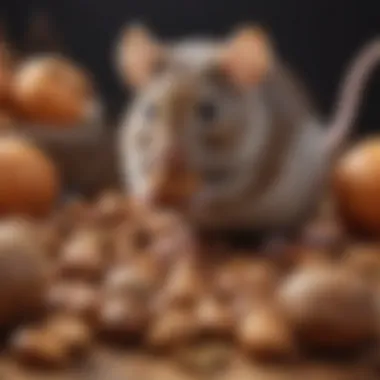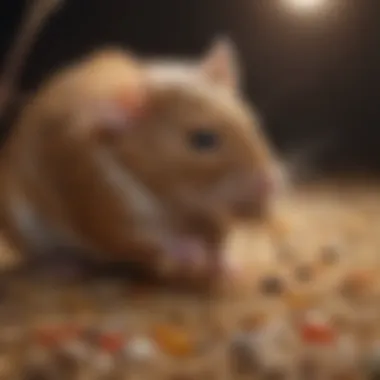Unveiling the Culinary Choices of Mice: A Glimpse into their Food Preferences


Animal Species Profile
Mice are small rodents that belong to the Muridae family. They are characterized by their rounded ears, long tails, and whiskers, which aid in their sensory perception. Mice are ubiquitous creatures found across the globe in various habitats, ranging from fields and forests to urban areas. Their adaptive nature allows them to thrive in a wide range of environments.
Animal Behavior & Psychology
In terms of behavior, mice are known for their agility and ability to quickly navigate through complex environments. They exhibit social interactions within their colonies, establishing hierarchies based on dominance. Mice communicate through a combination of vocalizations, body language, and pheromones, enabling effective coordination within the group. Furthermore, their reproductive behavior involves intricate courtship rituals and maternal care, highlighting their nurturing instincts.
Unique Facts & Trivia
Despite their small size, mice possess remarkable abilities such as exceptional agility and the capacity to squeeze through tiny openings due to their flexible skeletons. Additionally, mice are omnivores with a diverse palate, preferring seeds, grains, fruits, and even insects. A fascinating fact about mice is their keen sense of smell, which they rely on for locating food and perceiving their surroundings. These creatures showcase impressive problem-solving skills and adaptability, making them intriguing subjects of study.
Pet Care & Tips
For individuals considering mice as pets, it is essential to provide them with a suitable habitat containing bedding material, tunnels, and exercise wheels to cater to their active nature. Careful consideration should be given to their diet, consisting of a balanced mix of pellets, fresh vegetables, and occasional treats. Proper hygiene and regular veterinary check-ups are crucial for maintaining the health and well-being of pet mice. Interaction and socialization play a crucial role in keeping mice engaged and providing mental stimulation for these intelligent creatures.
Introduction
Delving into the intricate world of mice and their dietary preferences is a compelling journey that unveils the captivating foods that entice these diminutive creatures. By unraveling the favored food choices of mice, we gain valuable insights into their feeding habits and nutritional requirements.
Understanding Mice Food Preferences
The Significance of Studying Mice Diets
Diving into the significance of studying mice diets brings forth a crucial aspect of comprehending the dietary behaviors of these tiny mammals. By scrutinizing the diets of mice, researchers can unravel the intricate relationship between food preferences and overall health. This exploration sheds light on the critical role that dietary choices play in the life of mice, offering a deeper understanding of their behaviors and nutritional needs. Studying mice diets is instrumental in elucidating the impact of food on their well-being, providing valuable data for conducting comprehensive mouse behavior studies.
Natural Preferences of Mice
The section on natural preferences of mice is a crucial aspect of this article as it delves into the primary dietary inclinations of these small creatures. Understanding what mice naturally gravitate towards in terms of food is essential in comprehending their dietary needs and behaviors. By exploring the foods that mice instinctively prefer, we can gain valuable insights into their overall nutritional requirements and feeding patterns.
Seeds and Grains
Wheat and Oats


Delving into the specifics of wheat and oats provides a deeper understanding of how these grains contribute to the overall dietary preferences of mice. Wheat and oats are prominent choices due to their nutritional richness and availability in the wild. In the context of this article, the key characteristic of wheat and oats lies in their ability to provide essential nutrients for mice, such as fiber and carbohydrates. These grains are a popular choice among mice due to their widespread cultivation and easy access, making them a beneficial addition to a mouse's diet. However, one drawback of wheat and oats is their high carbohydrate content, which may need to be moderated to prevent obesity in mice.
Corn and Sunflower Seeds
When examining corn and sunflower seeds in relation to mice's natural preferences, we uncover significant insights into their dietary choices. Corn and sunflower seeds stand out for their high energy content and nutritional value, making them favorable options for mice. The key characteristic of these seeds is their protein and fat content, which are essential for the health and vitality of mice. In this article, the unique feature of corn and sunflower seeds lies in their role as enriching supplements in a mouse's diet. While these seeds offer advantages in terms of nutrition, excessive consumption can lead to weight gain, necessitating moderation.
Fruits and Vegetables
Apples and Carrots
Exploring the role of apples and carrots in mice's natural preferences sheds light on the significance of these fruits and vegetables in a mouse's diet. Apples and carrots are valued for their vitamin content and dietary fiber, making them nutritious choices for mice. The key characteristic of apples and carrots is their crunchy texture and sweet flavor, which appeals to mice's taste preferences. In this article, the unique feature of apples and carrots lies in their ability to provide essential vitamins and minerals crucial for a mouse's well-being. While these fruits and vegetables offer numerous advantages, overfeeding may lead to digestive issues in mice, emphasizing the need for moderation.
Broccoli and Spinach
Examining the role of broccoli and spinach in mice's natural preferences uncovers the nutritional benefits these greens offer. Broccoli and spinach are prized for their high vitamin and mineral content, serving as vital components of a mouse's diet. The key characteristic of broccoli and spinach is their antioxidants and nutrients that support overall health in mice. In this article, the unique feature of broccoli and spinach lies in their ability to fortify a mouse's immune system and promote longevity. Despite their benefits, excessive consumption of these greens may result in mineral imbalances in mice, underscoring the importance of controlled portions.
Nuts and Legumes
Almonds and Peanuts
Exploring the specifics of almonds and peanuts in relation to mice's natural preferences provides valuable insights into their dietary advantages. Almonds and peanuts are favored for their protein and healthy fats, making them beneficial choices for mice. The key characteristic of almonds and peanuts is their nutrient density and satiating properties, which support a mouse's dietary needs. In this article, the unique feature of almonds and peanuts lies in their contribution to a mouse's overall well-being and energy levels. However, due to their high fat content, these nuts should be given sparingly to prevent obesity and other health issues in mice.
Soybeans and Lentils
When delving into the role of soybeans and lentils in mice's natural preferences, we uncover the nutritional value these legumes offer. Soybeans and lentils are esteemed for their protein and fiber content, making them essential components of a mouse's diet. The key characteristic of soybeans and lentils lies in their versatility and ability to provide plant-based protein for mice. In this article, the unique feature of soybeans and lentils is their role in balancing a mouse's diet and promoting digestive health. Nonetheless, overconsumption of these legumes may lead to digestive discomfort in mice, warranting moderation in feeding practices.
Processed Foods Mice Enjoy
Processed foods play a crucial role in understanding the dietary preferences of mice in the wild and captivity. These food types offer researchers valuable insights into the adaptability and palate of these small creatures. By exploring the processed foods that entice mice, we can discern patterns in their consumption behavior and nutritional requirements. Understanding the significance of processed foods sheds light on the diverse dietary choices available to mice, contributing to a deeper comprehension of their feeding habits and needs.
Cereals and Crackers
Cereals and crackers are popular processed foods among mice, providing them with a convenient source of nutrition and energy. These items are commonly found in both natural habitats and human-inhabited areas, making them easily accessible to mice seeking sustenance. Let's delve into specific aspects of two favorite choices among mice:


Cornflakes and Wheat Crackers
Cornflakes and wheat crackers are staples in the diet of many mice due to their crunchy texture and mild flavor. These foods are rich in carbohydrates, offering a quick source of energy to sustain mice throughout their daily activities. The straightforward composition of cornflakes and wheat crackers makes them easy to digest, ensuring optimal utilization of nutrients by these tiny consumers. Despite their processing, these food items maintain some level of nutritional value, making them a suitable choice for mice looking for a quick and palatable meal.
Rice Krispies and Graham Crackers
Rice Krispies and graham crackers provide mice with a satisfying crunch and subtle sweetness, making them a delightful snack option. These foods contain a mix of carbohydrates and sugars, offering mice a balance of immediate energy and taste. The light and airy texture of Rice Krispies appeals to mice, while the wholesome flavor of graham crackers adds a touch of variety to their diet. However, the high sugar content in these items may pose potential health risks if consumed excessively, underscoring the importance of moderation in the consumption of these processed treats.
Cheese and Dairy Products
Cheese and dairy products hold a special place in the hearts of many mice, offering them a rich source of protein and calcium. These food items are not only tasty but also serve as essential components of a balanced diet for mice. Let's explore the characteristics of two beloved choices among mice:
Cheddar and Swiss Cheese
Cheddar and Swiss cheese are favored by mice for their sharp flavors and creamy textures. These cheeses provide mice with a concentrated source of protein, crucial for their muscle development and overall health. The calcium content in cheddar and Swiss cheese supports bone strength in mice, ensuring their skeletal structure remains robust. While these cheeses offer numerous nutritional benefits, their high-fat content requires cautious consumption by mice to prevent obesity and related health issues.
Yogurt and Milk
Yogurt and milk represent wholesome dairy options for mice, supplying them with probiotics and essential nutrients. Yogurt offers mice a gut-friendly bacteria that aids in digestion and supports their immune system. Milk, on the other hand, is a primary source of calcium for mice, promoting growth and vitality. Both yogurt and milk present mice with easily digestible dairy options, making them suitable for mice of all ages. However, lactose intolerance may limit some mice's ability to fully enjoy the benefits of dairy products, necessitating careful observation of individual tolerances.
Sweet Treats
Sweet treats add a touch of indulgence to a mouse's diet, offering them a chance to satisfy their cravings for something sugary. While these treats should be consumed in moderation, they provide mice with a delightful break from their regular food choices. Let's explore the characteristics of two popular sweet treats among mice:
Chocolate and Marshmallows
Chocolate and marshmallows are whimsical treats enjoyed by mice for their rich flavors and soft textures. These indulgent items offer mice a sweet escape from their daily diet, providing them with a burst of sugary delight. However, the high sugar and fat content in chocolate and marshmallows necessitates careful monitoring of portions to prevent weight gain and related health issues. Offering these treats as occasional rewards can keep mice satisfied without compromising their nutritional intake.
Honey and Maple Syrup
Honey and maple syrup introduce a natural sweetness to a mouse's diet, tempting their taste buds with earthy flavors. These liquid treats offer mice a distinct taste experience, adding depth to their culinary preferences. The antioxidants present in honey and maple syrup provide mice with potential health benefits, promoting overall well-being. Despite their natural origins, the high sugar content in these sweet syrups requires moderation in consumption to avoid disrupting a mouse's dietary balance. Integrating honey and maple syrup as occasional additives can enhance a mouse's mealtime enjoyment while prioritizing their nutritional needs.
Factors Influencing Mice Food Choices


In the captivating world of understanding mice food preferences, the aspects influencing their food choices play a significant role. These factors shape the dietary habits of mice, shedding light on their behavior and nutritional requirements. By delving into the factors that steer mice towards specific foods, we can unravel intricate patterns in their feeding choices, enriching our comprehension of these tiny creatures.
Genetics and Taste Preferences
Influence of Genetic Makeup
The genetic makeup of mice exerts a profound influence on their food preferences. It establishes a foundational basis for their taste receptors, dictating their inclination towards certain flavors and food types. This genetic predisposition plays a pivotal role in shaping mice's culinary likes and dislikes, influencing their feeding behaviors in a profound manner. Understanding the genetic underpinnings of mice's food preferences offers valuable insight into the intricate mechanisms driving their dietary choices.
Role of Taste Receptors
Taste receptors serve as essential components in determining mice's food preferences. These receptors enable mice to perceive and distinguish various flavors, guiding them towards preferred food sources. The sensitivity and specificity of these taste receptors play a crucial role in shaping mice's gustatory experiences, influencing their dietary decisions. By unraveling the role of taste receptors in mice, we gain a deeper understanding of how these tiny creatures navigate their culinary landscape.
Environmental Factors
Availability of Food Sources
The availability of food sources in mice habitats plays a pivotal role in shaping their dietary preferences. Access to a diverse range of food options influences the nutritional intake of mice, impacting their overall health and well-being. Understanding the significance of food availability in relation to mice's food choices provides key insights into the environmental factors driving their dietary habits.
Impact of Surrounding Habitat
The surrounding habitat exerts a significant impact on mice's food choices. The ecological context in which mice reside shapes the food options accessible to them, influencing their foraging patterns and dietary behaviors. By examining how the surrounding habitat impacts mice's dietary preferences, we can unravel the intricate relationship between environmental factors and food selection in these fascinating creatures.
Health and Nutritional Needs
Balancing Nutrients in Diet
Balancing nutrients in their diet is crucial for meeting mice's health and nutritional requirements. A diet that encompasses essential nutrients in the right proportions is essential for supporting mice's overall well-being and physiological functions. Understanding the importance of nutrient balance in mice's diet sheds light on the intricate dietary considerations necessary for maintaining their health.
Adapting to Dietary Requirements
Adapting to dietary requirements is a dynamic process for mice as they adjust their food choices based on varying nutritional needs. Mice exhibit adaptability in their feeding behaviors, modifying their diet to meet changing physiological demands. By exploring how mice adapt to diverse dietary requirements, we can gain valuable insights into their remarkable ability to adjust their food preferences in response to environmental and internal stimuli.
Conclusion
In wrapping up our exploration of the food preferences of mice, it becomes evident that understanding what mice enjoy eating is crucial for various research fields and practical applications. By delving into the culinary world of mice, we can uncover valuable insights into their dietary habits and nutritional requirements. This knowledge not only sheds light on the feeding behaviors of these small creatures but also aids in creating tailored diets for them in captive environments, such as research facilities or pet homes. Recognizing the foods that tickle a mouse's palate is fundamental for behavioral studies, as it can impact their performance and interactions with the surrounding environment. Furthermore, by deciphering mice's culinary preferences, we pave the way for enhanced care and enrichment strategies that cater to their natural inclinations, promoting overall health and well-being.
Insights into Mice's Culinary Preferences
Implications for Mouse Behavior Studies
Exploring the implications of mouse behavior studies offers a unique window into the intricacies of these tiny creatures' actions and responses. Understanding how mice interact with various food types not only provides valuable data for scientific research but also underpins the design and interpretation of behavioral experiments. This aspect of studying mouse behavior not only enriches our knowledge of their preferences but also serves as a foundation for broader investigations into learning, memory, and cognition. The behavioral insights gained from observing mice's culinary choices offer a glimpse into their adaptive mechanisms, foraging strategies, and social dynamics. By honing in on these behavioral patterns, researchers can decipher intricate relationships between diet, behavior, and overall well-being, thus enhancing our understanding of mice as unique and fascinating beings.







